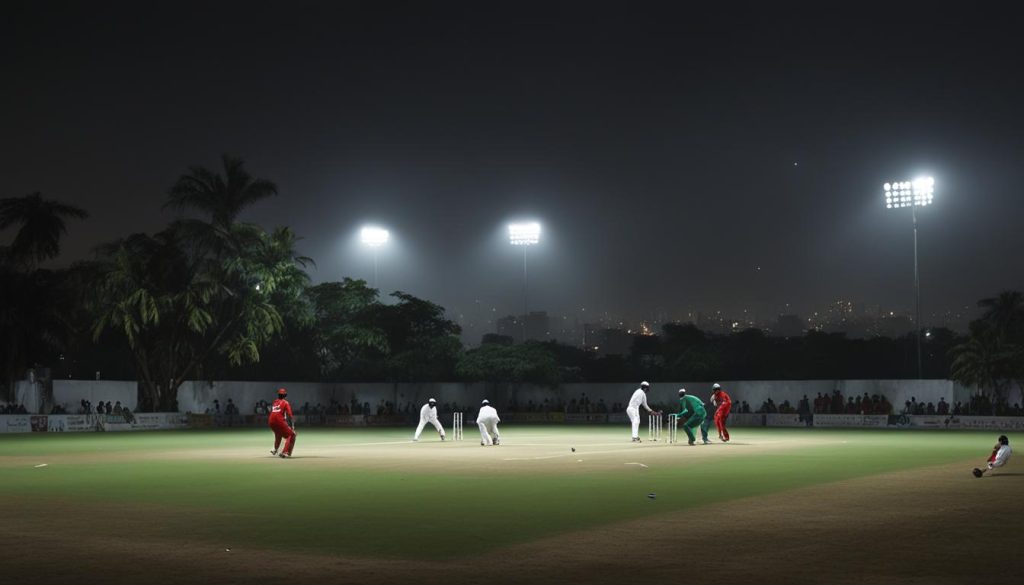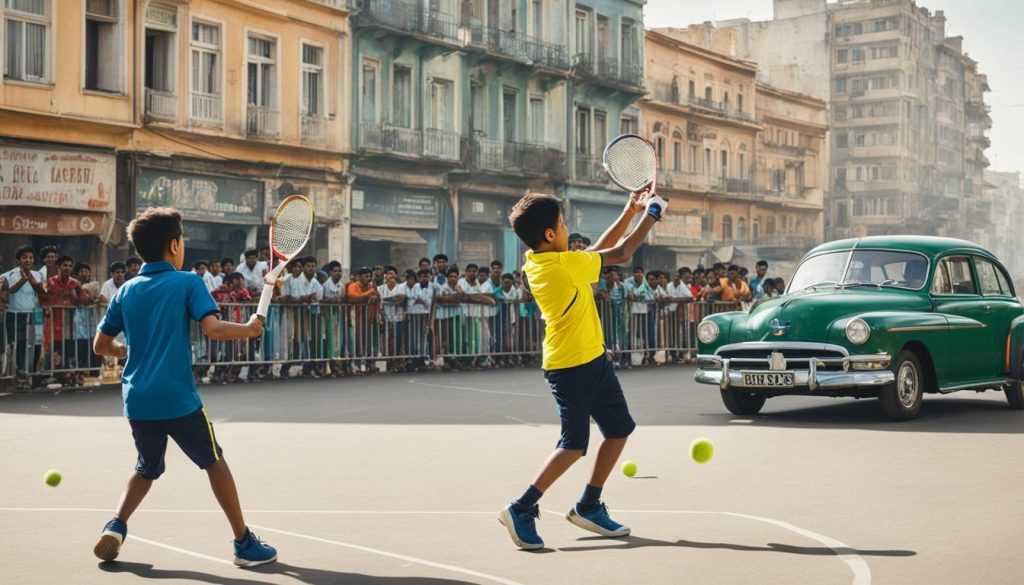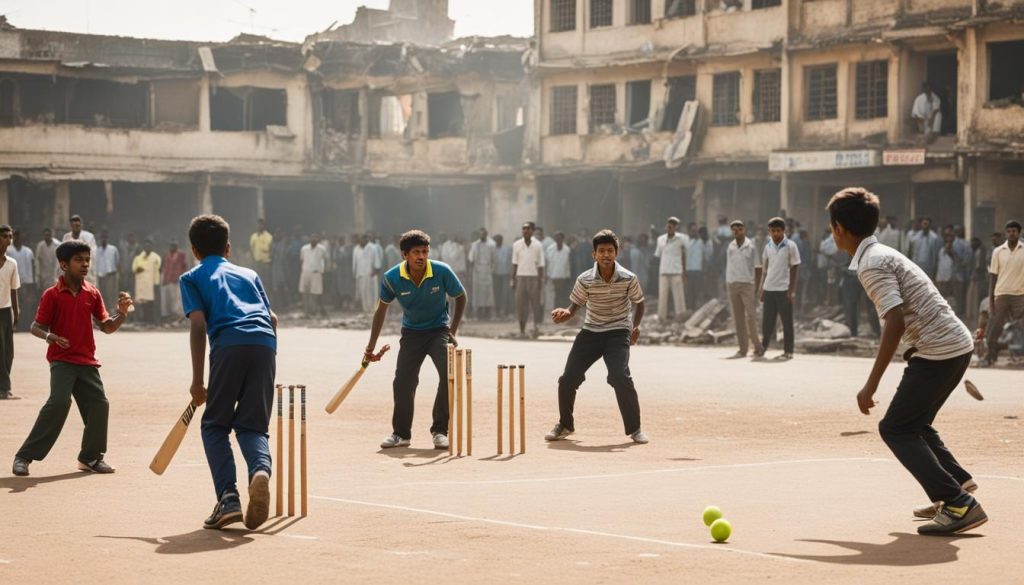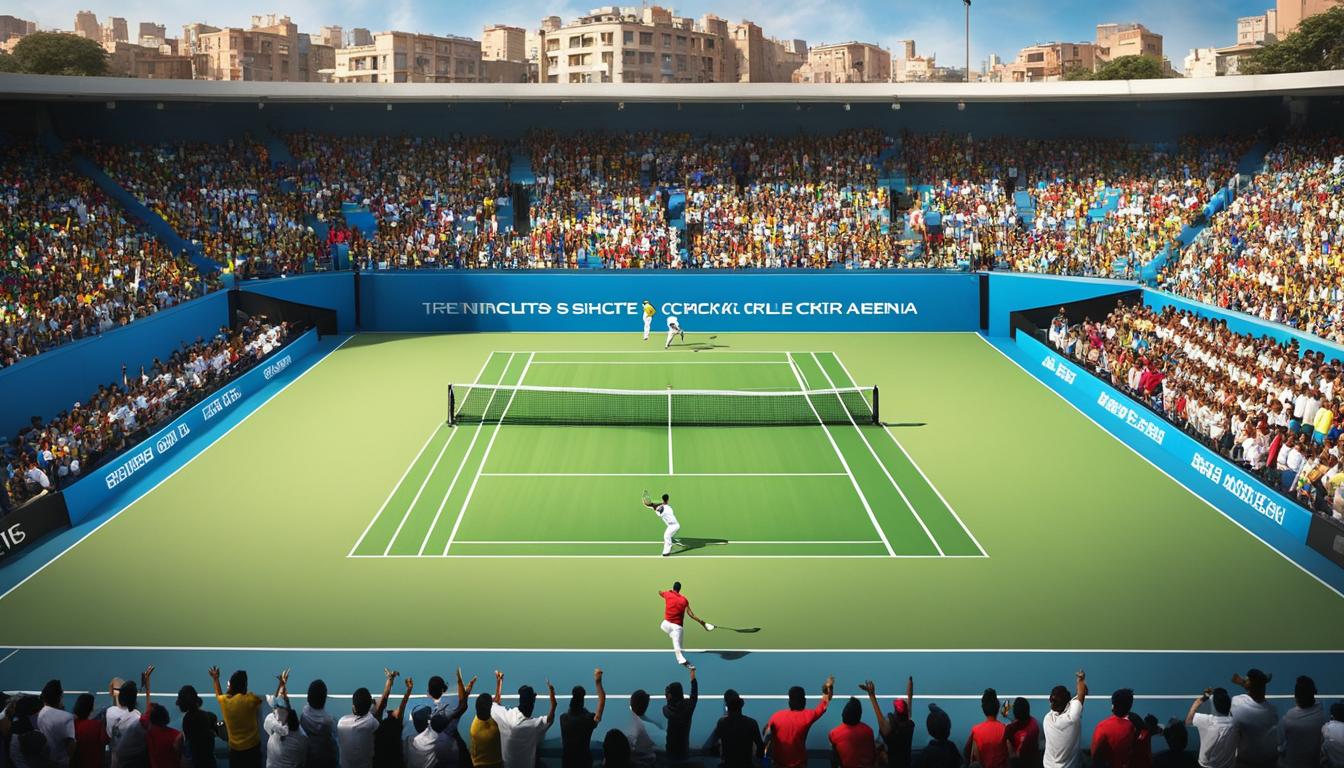I’ve always been captivated by how the urban landscapes transform, forging unique sporting arenas that are fueled by the passion and ingenuity of their inhabitants. In the bustling streets of Karachi, Pakistan, as the sun dips below the horizon and the call to prayer fades, something extraordinary happens during Ramadan. Tennis ball cricket, once just a street game, ascends to the urban stage, filling basketball courts and empty lots with the thwack of a heavily taped ball on bat. The essence of street cricket blooms in these impromptu settings. Here, urban cricket arenas echo with cheers and spirited calls, welcoming anyone with a will to play under the makeshift floodlights.
These games hold a special place in my heart, embodying an inclusive spirit where the accessibility of tennis ball cricket dissolves socioeconomic barriers. Fired by ambition or simply the joy of communal gathering, young men turn into valiant cricketers, and the narrow streets into theaters of dreams. None of this would be possible without the creativity that led to wrapping ordinary tennis balls with electrical tape, making a heavier ball that swings and seizes the night air without posing the risks that its leather counterpart would in such a condensed space.
Key Takeaways
- Tennis ball cricket is an accessible form of the sport that has grown from Pakistani streets to worldwide urban spaces.
- The electric atmosphere of night-time Ramadan cricket in Karachi showcases the game’s deep-rooted cultural significance.
- Wrapped tennis balls offer a safe and cost-efficient alternative to standard cricket balls, increasing the game’s inclusivity.
- Short matches lasting only a few overs provide a quick-paced and exciting format that’s perfect for densely populated urban areas.
- The adaptation of tennis balls with tape enhances the ball’s swing, elevating the street game closer to professional cricket dynamics.
- These makeshift matches become much more than a game, serving as a social event that unites communities.
The Birth of Tennis Ball Cricket in Urban Arenas
Delving into the archives of street cricket origins, one finds a tale woven into the fabric of Karachi’s urban backdrop. The genesis of tennis ball cricket is an ode to ingenuity – a version of the beloved sport designed to bridge socioeconomic divides. In the bustling metropolis of Karachi, a place now synonymous with urban cricket development, the tape-ball game found its footing amongst the city’s youth. Affordability was key. It allowed for the game’s widespread appeal and subsequent influx of participants from various walks of life.

The city’s rapid population growth during the 1960s laid the groundwork for a street-cricket revolution. Spaces for play were limited, so the game took to the streets, improvising with the resources at hand. The hum of the densely populated neighborhoods became the soundtrack to these impromptu matches. This was not just a game; it was a cricketing insurgency that would redefine the sport’s accessibility and reach.
As I delve deeper into the tape-ball game history, the innovations stand out starkly. It’s said that the introduction of electrical tape to the humble tennis ball was a pivotal moment. The purpose was to add weight and enable the ball to mimic the swing and seam of a traditional cricket ball, but without the associated risk of injury or breakages. This nuanced adaptation did more than change the game; it thrilled, it excited, and it inspired a new genre of cricketing strokes and styles.
Consider a timeline, not marked by precise dates but by the evolution of a game that surged from obscurity to become the lifeblood of cricket in urban Pakistan. From tape-ball beginnings, cricket has coursed through the narrow streets, open plots, and every conceivable space large enough for a pitch. The growth of this phenomenon exemplifies the raw passion for cricket, ascending from the earthy dust of Karachi’s alleys to stake its claim as an indomitable spirit within Pakistan’s sporting culture.
What began as a simple alternative to hard ball cricket burgeoned into a full-fledged movement. Evolving amidst the constraints of city life, it has undeniably shaped the way cricket is played and perceived. As I continue to explore the rich canvas of street cricket, these revelations not only chronicle a momentous chapter in sports history but resonate as a testament to the enduring allure of cricket in urban arenas.
The Thrill and Accessibility of Cricket with a Tennis Ball
The enchanting atmosphere of Karachi cricket after sundown is nothing short of a cultural phenomenon. Seamlessly, night tournaments have become a vibrant exhibition of global cricket passion, with the hum of the crowd and the clatter of wickets under the city lights. Tape ball cricket, an imaginative variation of the sport, has rooted itself firmly within the community, creating an accessible platform for aspiring cricketers and sports enthusiasts alike.

Accessible cricket in the form of tennis ball tournaments unlocks the game for every aspiring cricketer and spectator, establishing a sense of unity and excitement. I’ve witnessed these games bring together people of all ages and backgrounds, celebrating a shared passion that knows no bounds. The allure of cricket, especially during the month of Ramadan, sweeps through the city as hundreds gather to watch and participate in matches that continue late into the night.
From Karachi’s Night Tournaments to Global Passion
The fervor for tennis ball cricket transcends the bounds of Karachi, rippling through streets across the globe. In every corner, enthusiasts recreate the magic of accessible cricket, infusing their local flavor into the game. These night tournaments are a testament not just to the sport but to the communal spirit that thrives within it. Their evolution continues to mirror the ever-growing global cricket passion.
Cost-Effective Cricket for Aspiring Talents
In the bustling streets where cricket dreams soar, affordability is key. Tape ball cricket serves as an economical alternative to traditional cricket, allowing for the use of affordable cricket equipment. By simply wrapping a tennis ball in electrical tape, young cricketers find an avenue to express their love for the game without financial constraints.
Innovations and Adaptations: The Tape Ball Phenomenon
Invention is often born out of restriction, and the tape ball creation is a shining example of cricket adaptations at their finest. This innovation, hailing from the cricket-loving quarters of Karachi, has altered the landscape of urban cricket. Tape ball innovation has enabled faster-paced games while still keeping safety in check, forever changing the way cricket is played in confined spaces.
| Aspect | Tape Ball | Traditional Hard Ball |
|---|---|---|
| Affordability | Cost-effective | Expensive |
| Accessibility | Can be played anywhere | Requires designated space |
| Expected Audience | Street viewers to global online fans | Stadium crowds and TV viewers |
| Equipment | Tennis ball, electrical tape | Professional cricket gear |
| Safety | Reduced risk of injury | Higher risk, protective gear needed |
| Playing Style | Fast-paced, high energy | Technical, patience required |
The narrative of tennis ball cricket is continually unwinding, drawing new admirers and retaining the hardened affections of seasoned cricket lovers. With each swing of the bat and each cheer from the crowd, we are reminded of the unifying power of sport and the relentless ingenuity that spurs it onwards.
Cultural Impact and the Democratization of the Pitch
The cultural influence of cricket, especially street cricket, has been profound, breaking down societal barriers and extensively democratizing cricket. In my journey as a journalist, I have witnessed how street cricket has etched itself into the cultural fabric of countries such as Pakistan and India. The influence extends beyond avid sports lovers; it shapes community identities, forges friendships, and unites diverse social groups on an unprecedented level. Undoubtedly, the cricket cultural impact is palpable in the spirited matches on the bustling roads of Karachi and the narrow lanes of Mumbai where cricket is not just a game—it is a way of life.

The game, played in every nook and alley, is a testament to the street cricket influence. It has bolstered a unique sporting environment—one that is inclusive, accessible, and rich with raw talent. The democratization process does not merely open the pitch to all who wish to participate; it embeds the essence of the sport within the local culture, making it a binding thread among people regardless of their economic or social standing.
- The spellbinding vibrancy of impromptu cricket under open skies
- The seamless integration of cricket jargon into day-to-day language
- The exemplary inclusivity, uniting diverse demographics through batting and bowling
This transformation has become more evident as we see street cricket being enshrined in literature, cinema, and media, further amplifying its reach and solidifying its status within the cultural conscience. As these humble beginnings on the streets continue to shape the cricketing landscape, they reinforce the fact that greatness and passion often originate from the simplest of settings.
Tennis Ball Cricket’s Role in Shaping Professional Careers
As a journalist deeply immersed in the cricketing world, I’ve witnessed firsthand how the humble origins of street cricket have become a breeding ground for professional cricket careers. In Pakistan, the likes of Wasim Akram and Shaheen Shah Afridi have set a precedent for street cricket success. They owe their refined skills in part to the improvisation demanded by tennis ball cricket, an assertion that elevates the stature of these informal matches in the eyes of young cricket talents eager to emulate their heroes.

The Step from Street to Stadium: Success Stories
In the journey from impromptu games on the streets to the electrifying atmospheres of international stadiums, numerous Pakistan cricketers have drawn from their experiences in tennis ball cricket. It’s these formative moments on improvised cricket pitches that have helped shape the attitudes and aptitudes necessary for substantial cricket development. Their success stories serve as a powerful motivator for youth, infusing a sense of national cricket pride with every boundary scored.
Coaching Youth: The Grassroots of National Pride
The street is also a classroom where cricket coaching thrives through observation and practice. With youth development at the core of national pride, cricket coaching in these informal settings emphasizes skill-building over infrastructure. Coaches dedicated to nurturing young talent recognize that the harshness and unpredictability of the streets are what forge cricketers of remarkable adaptability and mental fortitude.
Building Skills on the Improvised Pitch
I’ve seen how the scarcity of traditional cricket facilities has turned roads, alleys, and even rooftops into hallowed cricketing grounds. There’s an undeniable charm and resourcefulness in the way a flat stone becomes a wicket and a narrow lane transforms into a pitch. Yet, beyond charm lies the crucible for skill-building—a place where tomorrow’s cricket talents master the art of cricketing improvisation that could one day illuminate their path towards professional ranks.
Conclusion
In my journey exploring the vibrant alleys and roaring fields of Karachi, I have witnessed first-hand the transformative power of tennis ball cricket. It’s not just a pastime; it’s a vital element fostering cricket within communities, summoning the spirit of competition and camaraderie that defines street cricket culture. The essence of tape ball cricket lies in its ingenious simplicity. It is as much about the thrill of the game as it is about the bonds it forges and the dreams it nurtures in the heart of every player who picks up a bat.
The sport has stealthily woven its way from the gullies to the grandeur of professional stadiums, creating a legacy that champions the game’s essence. Affordable and inclusive, this version of cricket strips away financial barriers and invites all to participate. It is this equitable foundation that resonates with me, revealing how a simple modification to a tennis ball can ignite passion and build potential in youth across nations.
As I reflect on what I’ve learned, I recognize that the beauty of tape ball cricket lies in its profound impact well beyond the fading lines of makeshift pitches. It serves as both a catalyst for change and a testament to innovation within cricket, illustrating that from every challenge, an opportunity can strike. This dynamic adaptation of cricket goes further than entertainment; it fosters a sense of belonging and offers a blueprint for how sports can be democratized for the greater good, encapsulating the pure, unadulterated essence of cricket at its core.
FAQ
What is tennis ball cricket?
Tennis ball cricket is a variation of traditional cricket played with a tennis ball instead of the standard leather ball. To make the ball heavier and conducive to swinging, it is often wrapped with electrical tape. This form of cricket is especially popular in urban areas where space and resources are limited.
How did tennis ball cricket originate in urban arenas?
Tennis ball cricket originated in Karachi, Pakistan, as an affordable alternative to traditional cricket, which was initially limited to upper-class clubs and schools. The growth in popularity of this format emerged alongside the city’s population boom in the 1960s, allowing a more inclusive form of the game to develop.
What makes cricket with a tennis ball so accessible?
Cricket with a tennis ball is accessible because it requires minimal equipment—just a tennis ball, electrical tape, and a bat, which significantly lowers the cost barrier. It can be played in compact spaces like streets and alleys, making it an excellent option for those who cannot access large cricket grounds or afford expensive gear.
Why are Karachi’s night tournaments significant?
The night tournaments in Karachi during Ramadan transform basketball courts and other spaces into vibrant cricket venues. These events are significant as they reflect the community’s passion for cricket, providing a platform for local talent to showcase their skills and for spectators to enjoy the game after a day of fasting.
How does a tape ball differ from a regular tennis ball in cricket?
A tape ball is a tennis ball modified with layers of electrical tape to add weight and alter its aerodynamics. This modification creates a ball that can swing and mimic the movement of a traditional cricket ball, making the game more challenging and competitive.
What impact does street cricket have on culture and sports democratization?
Street cricket has a significant cultural impact, bringing together people from all walks of life and democratizing the sport by erasing social class differences. It allows anyone with a passion for cricket to play and enjoy the game, regardless of their socio-economic background.
How has tennis ball cricket influenced professional cricket careers?
Many professional cricket players started playing with a tennis ball on the streets, which helped them develop their skills and resilience. The informal, challenging nature of street cricket often serves as an unconventional training ground, preparing players for successful careers in professional cricket.
Why is coaching youth in tennis ball cricket important for national pride?
Coaching young players in tennis ball cricket is important for national pride because it nurtures grassroots talent and helps develop a new generation of cricketers who could potentially represent their country on the international stage. It underscores the country’s commitment to the game from the community level upwards.
How does playing on improvised pitches help young cricketers build skills?
Playing on improvised cricket pitches, such as streets and alleys, forces young cricketers to adapt to varying conditions, which sharpens their techniques and enhances their gameplay. This level of adaptability and resourcefulness can contribute significantly to their development as versatile and skilled players.






